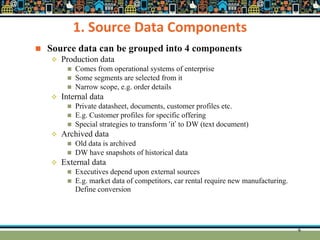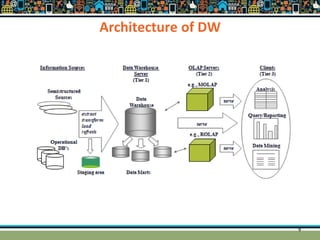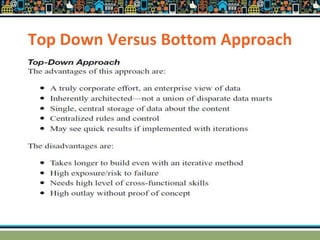3._DWH_Architecture__Components.ppt
- 2. Slide 2-2
- 3. 3 Agenda Data Warehouse architecture & building blocks ER modeling review Need for Dimensional Modeling Dimensional modeling & its inside Comparison of ER with dimensional
- 5. 5 Components Major components Source data component Data staging component Information delivery component Metadata component Management and control component
- 6. 6 1. Source Data Components Source data can be grouped into 4 components Production data Comes from operational systems of enterprise Some segments are selected from it Narrow scope, e.g. order details Internal data Private datasheet, documents, customer profiles etc. E.g. Customer profiles for specific offering Special strategies to transform ‘it’ to DW (text document) Archived data Old data is archived DW have snapshots of historical data External data Executives depend upon external sources E.g. market data of competitors, car rental require new manufacturing. Define conversion
- 8. 8 2. Data Staging Components After data is extracted, data is to be prepared Data extracted from sources needs to be changed, converted and made ready in suitable format Three major functions to make data ready Extract Transform Load Staging area provides a place and area with a set of functions to Clean Change Combine Convert
- 10. 10 3. Data Storage Components Separate repository Data structured for efficient processing Redundancy is increased Updated after specific periods Only read-only
- 12. 12 4. Information Delivery Component Authentication issues Active monitoring services Performance, DBA note selected aggregates to change storage User performance Aggregate awareness E.g. mining, OLAP etc
- 13. Slide 2-13
- 14. 14 DW Design
- 16. 16 Background (ER Modeling) For ER modeling, entities are collected from the environment Each entity act as a table Success reasons Normalized after ER, since it removes redundancy (to handle update/delete anomalies) But number of tables is increased Is useful for fast access of small amount of data
- 17. ER Drawbacks for DW / Need of Dimensional Modeling ER Hard to remember, due to increased number of tables Complex for queries with multiple tables (table joins) Conventional RDBMS optimized for small number of tables whereas large number of tables might be required in DW Ideally no calculated attributes The DW does not require to update data like in OLTP system so there is no need of normalization OLAP is not the only purpose of DW, we need a model that facilitate integration of data, data mining, historically consolidated data. Efficient indexing scheme to avoid screening of all data De-Normalization (in DW) Add primary key Direct relationships Re-introduce redundancy 17
- 18. 18 Dimensional Modeling Dimensional Modeling focuses subject- orientation, critical factors of business Critical factors are stored in facts Redundancy is no problem, achieve efficiency Logical design technique for high performance Is the modeling technique for storage
- 19. Dimensional Modeling (cont.) Two important concepts Fact Numeric measurements, represent business activity/event Are pre-computed, redundant Example: Profit, quantity sold Dimension Qualifying characteristics, perspective to a fact Example: date (Date, month, quarter, year) 19
- 20. 20 Dimensional Modeling (cont.) Facts are stored in fact table Dimensions are represented by dimension tables Dimensions are degrees in which facts can be judged Each fact is surrounded by dimension tables Looks like a star so called Star Schema
- 21. 21 Example TIME time_key (PK) SQL_date day_of_wee k month STORE store_key (PK) store_ID store_name address district floor_type CLERK clerk_key (PK) clerk_id PRODUCT product_key (PK) SKU description brand category CUSTOMER customer_key (PK) customer_nam e purchase_profi le credit_profile address PROMOTION promotion_key (PK) promotion_nam FACT time_key (FK) store_key (FK) clerk_key (FK) product_key (FK) customer_key (FK) promotion_key (FK) dollars_sold units_sold
- 22. 22 Inside Dimensional Modeling Inside Dimension table Key attribute of dimension table, for identification Large no of columns, wide table Non-calculated attributes, textual attributes Attributes are not directly related Un-normalized in Star schema Ability to drill-down and drill-up are two ways of exploiting dimensions Can have multiple hierarchies Relatively small number of records
- 23. 23 Inside Dimensional Modeling Have two types of attributes Key attributes, for connections Facts Inside fact table Concatenated key Grain or level of data identified Large number of records Limited attributes Sparse data set Degenerate dimensions (order number Average products per order) Fact-less fact table
- 24. 24 Star Schema Keys Primary keys Identifying attribute in dimension table Relationship attributes combine together to form P.K Surrogate keys Replacement of primary key System generated Foreign keys Collection of primary keys of dimension tables Primary key to fact table System generated Collection of P.Ks
- 25. 25 Advantage of Star Schema Ease for users to understand Optimized for navigation (less joins fast) Most suitable for query processing Karen Corral, et al. (2006) The impact of alternative diagrams on the accuracy of recall: A comparison of star-schema diagrams and entity-relationship diagrams, Decision Support Systems, 42(1), 450-468.
- 26. DATA WAREHOUSES AND DATA MARTS
- 27. DATA WAREHOUSES AND DATA MARTS Bill Inmon stated, “The single most important issue facing the IT manager this year is whether to build the data warehouse first or the data mart first.” This statement is true even today. Let us examine this statement and take a stand Before deciding to build a data warehouse for your organization, you need to ask the Following basic and fundamental questions and address the relevant issues: Top-down or bottom-up approach? Enterprise-wide or departmental? Which first—data warehouse or data mart? Build pilot or go with a full-fledged implementation? Dependent or independent data marts?
- 28. Data Granularity
- 29. Top Down Versus Bottom Approach
- 31. A Practical Approach In order to formulate an approach for your organization, you need to examine what exactly Your organization wants. Is your organization looking for long-term results or fast data Marts for only a few subjects for now? Does your organization want quick, proof-of-concept, Throw-away implementations? Or, do you want to look into some other practical approach?
- 32. Although both the top-down and the bottom-up approaches each have their own advantages and drawbacks, a compromise approach accommodating both views appears to be practical. The chief proponent of this practical approach is Ralph Kimball, an eminent author and data warehouse expert. The steps in this practical approach are as follows: 1. Plan and define requirements at the overall corporate level 2. Create a surrounding architecture for a complete warehouse 3. Conform and standardize the data content 4. Implement the data warehouse as a series of supermarts, one at a time
- 33. METADATA IN THE DATA WAREHOUSE Types of Metadata Metadata in a data warehouse fall into three major categories: Operational Metadata Extraction and Transformation Metadata End-User Metadata
- 34. Operational Metadata As you know, data for the data warehouse comes from several operational systems of the enterprise. These source systems contain different data structures. The data elements selected for the data warehouse have various field lengths and data types. In selecting data from the source systems for the data warehouse, you split records, combine parts of records from different source files, and deal with multiple coding schemes and field lengths. When you deliver information to the end-users, you must be able to tie that back to the original source data sets. Operational metadata contain all of this information about the operational data sources.
- 35. Extraction and Transformation Metadata Extraction and transformation metadata contain data about the extraction of data from the source systems, namely, the extraction frequencies, extraction methods, and business rules for the data extraction. Also, this category of metadata contains information about all the data transformations that take place in the data staging area. End-User Metadata The end-user metadata is the navigational map of the data warehouse. It enables the end-users to find information from the data warehouse. The end-user metadata allows the end-users to use their own business terminologies.
- 36. Significance Why is metadata especially important in a data warehouse? First, it acts as the glue that connects all parts of the data warehouse. Next, it provides information about the contents and structures to the developers. Finally, it opens the door to the end-users and makes the contents recognizable in their own terms.
- 37. Exercise A data warehouse is subject-oriented. What would be the major critical business subjects for the following companies? An international manufacturing company A local community bank A domestic hotel chain You are the data analyst on the project team building a data warehouse for an insurance company. List the possible data sources from which you will bring the data into your data warehouse. State your assumptions. For an airlines company, identify three operational applications that would feed into the data warehouse. What would be the data load and refresh cycles? Prepare a table showing all the potential users and informationdelivery methods for a data warehouse supporting a large national grocery chain. Copyright © 2014 Pearson Education, Inc. Publishing as Prentice Hall Slide 2-37




































